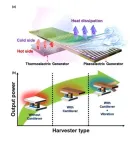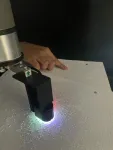(Press-News.org) A sequence variant that increases risk of pregnancy loss
Scientists at deCODE genetics, a subsidiary of Amgen and their collaborators from Iceland, Denmark and USA published a study today in Nature Structural and Molecular Biology titled “Variant in the synaptonemal complex protein SYCE2 associates with pregnancy loss through effects on recombination”.
While it is well established that chromosomal abnormalities are a major cause of miscarriages the biology behind pregnancy losses with or without chromosomal errors is not well understood. Over 114 thousand women from Iceland, Denmark, UK, USA and Finland who have experienced pregnancy loss participated in a genome-wide association study, testing 50 million sequence variants. A low frequency missense variant in the SYCE2 gene was found to increase the risk of pregnancy loss by 22%.
In a previous report by deCODE scientists this missense variant was shown to associate with recombination phenotypes in chromosomes that were transmitted from the mother. Recombination between homologous chromosomes is an essential part of meiosis, the generation of the human egg and sperm cell. The product of SYCE2 forms a part of a protein complex that is essential for the alignment of homologous chromosomes for recombination and the missense variant associating with pregnancy loss and recombination is predicted to affect the stability of this protein complex.
A closer inspection of the effect of the variant on recombination revealed an effect on positioning of crossovers that is proportional to the length of the chromosomes, the longer the chromosome the larger the effect. The effect on recombination is measured in live born individuals. The authors propose that this effect may be more extreme in pregnancies that are lost and may contribute to the pregnancy loss. The association with pregnancy loss does not account for embryos lost in early gestation before pregnancy has been detected so the effect of the variant on pregnancy success may be underestimated.
The findings reported in this study demonstrate that a variant with a substantial effect on recombinations can be maintained in the population despite increasing the risk of pregnancy loss.
----------------------------
Based in Reykjavik, Iceland, deCODE is a global leader in analyzing and understanding the human genome. Using its unique expertise and population resources, deCODE has discovered genetic risk factors for dozens of common diseases. deCODE is a wholly-owned subsidiary of Amgen (NASDAQ:AMGN).
END
Variant in the synaptonemal complex protein SYCE2 associates with pregnancy loss through effects on recombination
2024-01-29
ELSE PRESS RELEASES FROM THIS DATE:
How obesity dismantles our mitochondria
2024-01-29
The number of people with obesity has nearly tripled since 1975, resulting in a worldwide epidemic. While lifestyle factors like diet and exercise play a role in the development and progression of obesity, scientists have come to understand that obesity is also associated with intrinsic metabolic abnormalities. Now, researchers from University of California San Diego School of Medicine have shed new light on how obesity affects our mitochondria, the all-important energy-producing structures of our cells.
In a study published January ...
Cancer treatment two and a half times more effective when tumours have defective "energy factories"
2024-01-29
Cancer Research UK-funded scientists have made an unusual discovery that could help to identify patients who are up to two and a half times more likely to respond to currently available cancer drugs.
Scientists at the Cancer Research UK Scotland Institute and Memorial Sloan Kettering Cancer Centre in the USA have “rewired” the DNA of mitochondria – energy factories found in every living cell. They found that creating mutations in parts of this DNA determines how well cancer will respond to immunotherapy – treatments which harness the body’s natural defences ...
How does a “reverse sprinkler” work? Researchers solve decades-old physics puzzle
2024-01-29
For decades scientists have been trying to solve Feynman’s Sprinkler Problem: How does a sprinkler running in reverse—in which the water flows into the device rather than out of it—work? Through a series of experiments, a team of mathematicians has figured out how flowing fluids exert forces and move structures, thereby revealing the answer to this long-standing mystery.
“Our study solves the problem by combining precision lab experiments with mathematical modeling that explains how a reverse sprinkler operates,” explains Leif Ristroph, an associate professor at New York University’s Courant Institute of Mathematical Sciences and the senior author ...
Neuroblastoma: Liquid biopsies to detect relapse of childhood cancer early
2024-01-29
(Utrecht/Vienna, 29.1.2024) Neuroblastoma mainly affects toddlers and young children - in the EU region there are 1500 new cases per year. Neuroblastoma is a malignant tumor of the peripheral nervous system and around 50% of patients are high-risk cases. Recurrences occur frequently, and conventional therapies are no longer effective for these children. With liquid biopsies it is possible to monitor therapy success and to predict the recurrence of the tumor in time to take medical countermeasures. Scientists from leading European ...
Speaking in a local accent might make social robots seem more trustworthy and competent
2024-01-29
Social robots can help us with many things: teaching, learning, caring. Because they’re designed to interact with humans, they’re designed to make us comfortable — and that includes the way they talk. But how should they talk? Some research suggests that people like robots to use a familiar accent or dialect, while other research suggests the opposite.
“Surprisingly, people have mixed feelings about robots speaking in a dialect — some like it, while others prefer standard language,” said Katharina Kühne of the University of Potsdam, lead author ...
Hybrid energy harvesters that harness heat and vibration simultaneously
2024-01-29
Harvesting energy sources such as heat, vibration, light, and electromagnetic waves from everyday environments such as industrial sites and automobiles and converting them into electrical energy is known as energy harvesting. Energy harvesting makes it easier to power today's popular IoT sensors and wireless devices that are located in environments where battery replacement is difficult.
Dr. Hyun-Cheol Song and Dr. Sunghoon Hur of Electronic Materials Research Center at the Korea Institute of Science and Technology (KIST) have developed a hybrid energy harvesting ...
Organ donations after MAiD made up 14% of deceased donations in Quebec
2024-01-29
Organ donation after medical assistance in dying (MAiD) represented 14% of Quebec's total deceased donations in 2022, according to a new study in CMAJ (Canadian Medical Association Journal) https://www.cmaj.ca/lookup/doi/10.1503/cmaj.230883.
To understand the impact of organ donation after MAiD, Quebec researchers analyzed data on all patients referred to Transplant Québec for possible organ donation after MAiD from January 2018 to December 2022. This represented the first 5 full years when organ donation after MAiD was allowed in the province. Over the 5-year period, Transplant Québec received 245 referrals for donation after MAiD, ...
Polycystic ovarian syndrome: new review to help diagnose and manage
2024-01-29
A new review in CMAJ (Canadian Medical Association Journal) is aimed at helping clinicians diagnose and manage polycystic ovarian syndrome (PCOS), an endocrine disorder that affects about 10% of femaleshttps://www.cmaj.ca/lookup/doi/10.1503/cmaj.231251.
This disorder affects females of reproductive age and is associated with infertility, miscarriage and pregnancy complications. Its long-term health consequences include hypertension, cancer risks, and metabolic and psychological impacts. Patients usually present to health care between ages 18 and 39 years complaining of menstrual cycle irregularities, ...
Robot trained to read braille at twice the speed of humans
2024-01-29
Researchers have developed a robotic sensor that incorporates artificial intelligence techniques to read braille at speeds roughly double that of most human readers.
The research team, from the University of Cambridge, used machine learning algorithms to teach a robotic sensor to quickly slide over lines of braille text. The robot was able to read the braille at 315 words per minute at close to 90% accuracy.
Although the robot braille reader was not developed as an assistive technology, the researchers say the high sensitivity required to read braille makes it an ideal test in the development of robot ...
Obesity and alcohol are contributing to increases in bowel cancer rates among young adults
2024-01-29
Overweight and obesity are contributing to rising death rates from bowel cancer among people aged 25-49 years in the European Union (EU) and the UK, although death rates from this type of cancer are decreasing overall across Europe.
These findings are from a new study published in the leading cancer journal Annals of Oncology [1] today (Monday), which predicts death rates from cancer in the EU and UK for 2024. It is the first time that an increase in bowel cancer death rates among young adults has been predicted for the EU, and it confirms a trend in the UK that the researchers first noted in 2021.
Researchers led by Carlo La Vecchia (MD), ...






